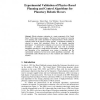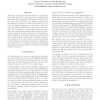CVIU
2007
14 years 2 months ago
2007
One goal for future Mars missions is for a rover to be able to navigate autonomously to science targets not visible to the rover, but seen in orbital or descent images. This can b...
MVA
1998
14 years 4 months ago
1998
Current NASA plans call for extended year-long, multikilometer treks for the 2003 and 2005 Mars missions. A much greater amount of rover autonomy is required compared to the recen...
ICRA
1998
IEEE
14 years 7 months ago
1998
IEEE
This paper describes maximum likelihood estimation techniques for performing rover localization in natural terrain by matching range maps. An occupancy map of the local terrain is...
ICRA
1998
IEEE
14 years 7 months ago
1998
IEEE
Recently a planetary rover returned important scientific information from Mars. More ambitious missions are planned. New planning methods are required that allow rovers to explore...
ISER
1999
Springer
14 years 7 months ago
1999
Springer
: Robotic planetary exploration is a major component of the United States’ NASA space science program. The focus of our research is to develop rover planning and control algorith...
ICRA
2000
IEEE
14 years 7 months ago
2000
IEEE
Autonomous planetary rovers operating in vast unknown environments must operate efficiently because of size, power and computing limitations. Recently, we have developed a rover c...
ICRA
2002
IEEE
14 years 8 months ago
2002
IEEE
This paper investigates kinetic behavior of a planetary rover with attention to tire-soil traction mechanics and articulated body dynamics, and thereby study the control when the ...
ICRA
2008
IEEE
14 years 9 months ago
2008
IEEE
— This paper presents slope traversal experiments with slip compensation control for lunar/planetary exploration rovers. On loose soil, wheels of the rover easily slip even when ...


